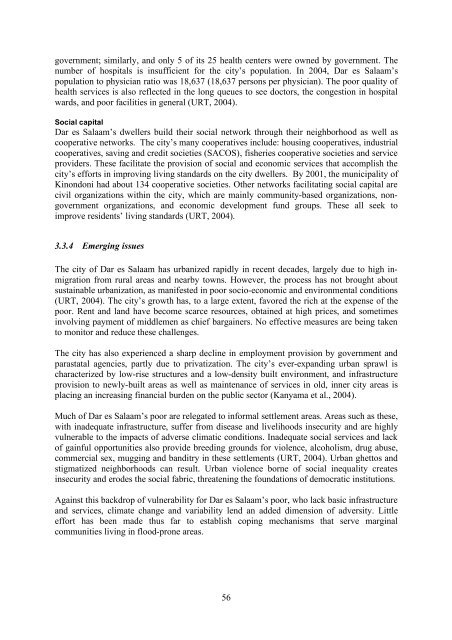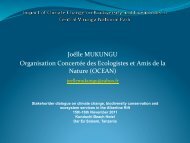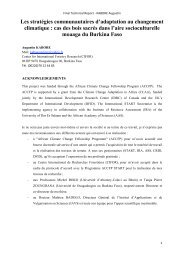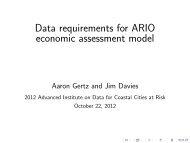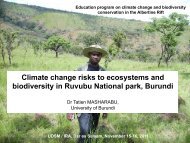Urban Poverty & Climate Change in Dar es Salaam, Tanzania:
Urban Poverty & Climate Change in Dar es Salaam, Tanzania:
Urban Poverty & Climate Change in Dar es Salaam, Tanzania:
Create successful ePaper yourself
Turn your PDF publications into a flip-book with our unique Google optimized e-Paper software.
government; similarly, and only 5 of its 25 health centers were owned by government. The<br />
number of hospitals is <strong>in</strong>sufficient for the city’s population. In 2004, <strong>Dar</strong> <strong>es</strong> <strong>Salaam</strong>’s<br />
population to physician ratio was 18,637 (18,637 persons per physician). The poor quality of<br />
health servic<strong>es</strong> is also reflected <strong>in</strong> the long queu<strong>es</strong> to see doctors, the cong<strong>es</strong>tion <strong>in</strong> hospital<br />
wards, and poor faciliti<strong>es</strong> <strong>in</strong> general (URT, 2004).<br />
Social capital<br />
<strong>Dar</strong> <strong>es</strong> <strong>Salaam</strong>’s dwellers build their social network through their neighborhood as well as<br />
cooperative networks. The city’s many cooperativ<strong>es</strong> <strong>in</strong>clude: hous<strong>in</strong>g cooperativ<strong>es</strong>, <strong>in</strong>dustrial<br />
cooperativ<strong>es</strong>, sav<strong>in</strong>g and credit societi<strong>es</strong> (SACOS), fisheri<strong>es</strong> cooperative societi<strong>es</strong> and service<br />
providers. Th<strong>es</strong>e facilitate the provision of social and economic servic<strong>es</strong> that accomplish the<br />
city’s efforts <strong>in</strong> improv<strong>in</strong>g liv<strong>in</strong>g standards on the city dwellers. By 2001, the municipality of<br />
K<strong>in</strong>ondoni had about 134 cooperative societi<strong>es</strong>. Other networks facilitat<strong>in</strong>g social capital are<br />
civil organizations with<strong>in</strong> the city, which are ma<strong>in</strong>ly community-based organizations, nongovernment<br />
organizations, and economic development fund groups. Th<strong>es</strong>e all seek to<br />
improve r<strong>es</strong>idents’ liv<strong>in</strong>g standards (URT, 2004).<br />
3.3.4 Emerg<strong>in</strong>g issu<strong>es</strong><br />
The city of <strong>Dar</strong> <strong>es</strong> <strong>Salaam</strong> has urbanized rapidly <strong>in</strong> recent decad<strong>es</strong>, largely due to high <strong>in</strong>migration<br />
from rural areas and nearby towns. However, the proc<strong>es</strong>s has not brought about<br />
susta<strong>in</strong>able urbanization, as manif<strong>es</strong>ted <strong>in</strong> poor socio-economic and environmental conditions<br />
(URT, 2004). The city’s growth has, to a large extent, favored the rich at the expense of the<br />
poor. Rent and land have become scarce r<strong>es</strong>ourc<strong>es</strong>, obta<strong>in</strong>ed at high pric<strong>es</strong>, and sometim<strong>es</strong><br />
<strong>in</strong>volv<strong>in</strong>g payment of middlemen as chief barga<strong>in</strong>ers. No effective measur<strong>es</strong> are be<strong>in</strong>g taken<br />
to monitor and reduce th<strong>es</strong>e challeng<strong>es</strong>.<br />
The city has also experienced a sharp decl<strong>in</strong>e <strong>in</strong> employment provision by government and<br />
parastatal agenci<strong>es</strong>, partly due to privatization. The city’s ever-expand<strong>in</strong>g urban sprawl is<br />
characterized by low-rise structur<strong>es</strong> and a low-density built environment, and <strong>in</strong>frastructure<br />
provision to newly-built areas as well as ma<strong>in</strong>tenance of servic<strong>es</strong> <strong>in</strong> old, <strong>in</strong>ner city areas is<br />
plac<strong>in</strong>g an <strong>in</strong>creas<strong>in</strong>g f<strong>in</strong>ancial burden on the public sector (Kanyama et al., 2004).<br />
Much of <strong>Dar</strong> <strong>es</strong> <strong>Salaam</strong>’s poor are relegated to <strong>in</strong>formal settlement areas. Areas such as th<strong>es</strong>e,<br />
with <strong>in</strong>adequate <strong>in</strong>frastructure, suffer from disease and livelihoods <strong>in</strong>security and are highly<br />
vulnerable to the impacts of adverse climatic conditions. Inadequate social servic<strong>es</strong> and lack<br />
of ga<strong>in</strong>ful opportuniti<strong>es</strong> also provide breed<strong>in</strong>g grounds for violence, alcoholism, drug abuse,<br />
commercial sex, mugg<strong>in</strong>g and banditry <strong>in</strong> th<strong>es</strong>e settlements (URT, 2004). <strong>Urban</strong> ghettos and<br />
stigmatized neighborhoods can r<strong>es</strong>ult. <strong>Urban</strong> violence borne of social <strong>in</strong>equality creat<strong>es</strong><br />
<strong>in</strong>security and erod<strong>es</strong> the social fabric, threaten<strong>in</strong>g the foundations of democratic <strong>in</strong>stitutions.<br />
Aga<strong>in</strong>st this backdrop of vulnerability for <strong>Dar</strong> <strong>es</strong> <strong>Salaam</strong>’s poor, who lack basic <strong>in</strong>frastructure<br />
and servic<strong>es</strong>, climate change and variability lend an added dimension of adversity. Little<br />
effort has been made thus far to <strong>es</strong>tablish cop<strong>in</strong>g mechanisms that serve marg<strong>in</strong>al<br />
communiti<strong>es</strong> liv<strong>in</strong>g <strong>in</strong> flood-prone areas.<br />
56


